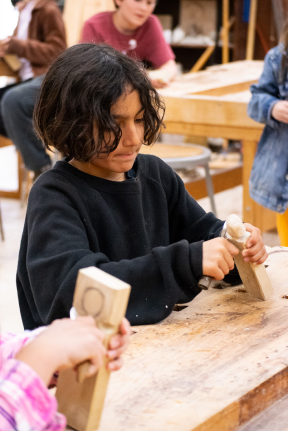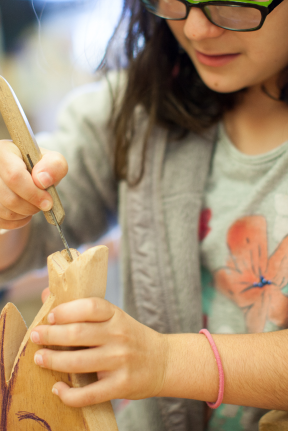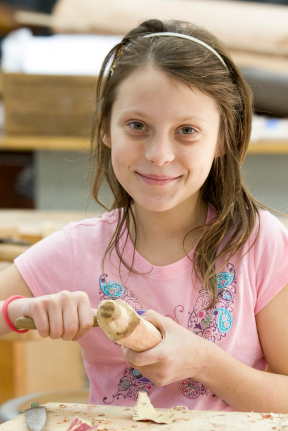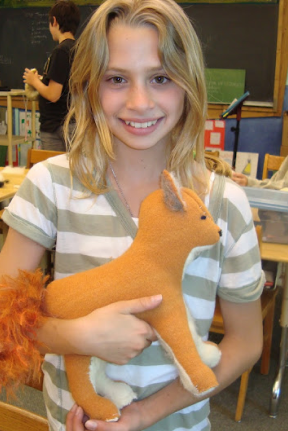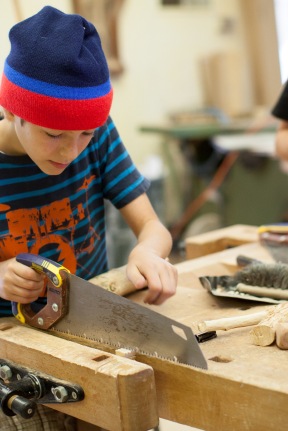The Arts: The Cornerstone of Waldorf Education
The arts are an integral part of the Waldorf curriculum. Every student is exposed to a wide array of artistic disciplines starting in the first grade. These include music, fine arts, practical arts and drama.
Painting
First and second graders explore the interaction of color while listening to a simple story during their painting class. Third graders create compositions that express the content of a story as well as the mood of a season. Painting in the fourth grade is linked to nature studies, trees, simple landscapes, animals and figurative themes from the history or geography blocks. Students explore light and dark shades in fifth grade.
Sixth graders begin to experience shadows, landscapes, and color contrasts that are taken up in painting, drawing and sometimes pastels. This is also the time where Sixth-grade geometry is an ideal place to bring all the years of circle movement from eurythmy and some form drawing into exact mathematical constructions using compasses, rulers, and right angles. Seventh and eighth graders explore light and color through different times of the day, learn perspective from Renaissance artists, create frescoes and work with pastels, and learn veil painting, a technique in which the artist uses gradual layers of color to create images.
Eurythmy
Eurythmy was created by Rudolf Steiner, the philosopher, intellectual, and founder of Waldorf education, when asked if new meaning could be given to the art of dance. Steiner explored the world of speech and music, seeking archetypal forms and movements within the sounds themselves. From this exploration came Eurythmy, a unique movement art that is used in education and enjoyed in performance around the world.
Through eurythmy, children learn social awareness, spatial orientation, coordination, and artistic expression. They begin the exploration of straight and curved lines and elements of pitch and rhythm. Through the grades they explore spatial and geometric forms and gestures for vowels and consonants. The classes learn to move together through increasingly intricate patterns and explore movement through a variety of poetry and musical pieces.
Handwork & Woodworking
Development of fine motor skills, concentration, aesthetic sensibility, tenacity and mathematics skills
First graders fashion their own knitting needles from a set of wooden dowels and then use them to learn knitting skills including casting on and off. Second graders advance their knitting skills with purling and sewing up their creations. Third graders learn crochet, a new challenge in coordination. To accompany their study of farming, the children also learn to spin and dye raw wool. In the fourth grade, the curriculum shifts to embroidery. Children use their artistic skills to create design ideas and their craft skills to implement them. Fifth graders return to knitting and undertake knitting in the round and create socks and hats. Students create patterns based on mathematical formulas and have to concentrate to remain true to their pattern. Middle school age students take on increasingly complex projects: hand-sewn stuffed animals, quilts and flannel pajamas sewn on a machine.
In their Woodworking Class, students create a variety of utilitarian objects from wood: spoons, simple propellers, bowls, stools, and small boxes. Wood is a challenging medium, and students learn the importance of planning and preparation. Students also learn about the usage of tools: saws, rasps, gouge and mallet, drills, and carving knives. Through practice they develop a sense of form and learn to work together in a safe woodshop environment.
Artistic Courses in the High School
In the High School, required and elective artistic courses include Sculpting, Watercolor Painting, Life Drawing, Veil Painting, Jewelry Making, Stone Carving, Copper Smithing, Black & White Drawing, Eurythmy, Drama, and Blacksmithing, in addition to their music classes.
Blacksmithing is a foundational art for humanity that dates back over 3000 years with roots much deeper in prehistory. Academic subjects such as physics, chemistry, and thermodynamics are brought to life and given practical meaning through project-based learning. This gives a sense of meaningful accomplishment when the student finishes forging an object. It is empowering to transform solid steel, to use the four elements of earth, water, air, and fire to bend the iron to our will. It is one of our unique offerings at our school.
